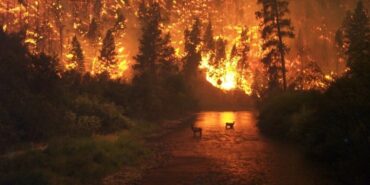 Study Finds Wildfires Amplify Effects of Short-term Exposure to Particulate Matter on COVID-19 Cases and Deaths
Study Finds Wildfires Amplify Effects of Short-term Exposure to Particulate Matter on COVID-19 Cases and Deaths
As of August 17, 2021, nine new wildfires were reported across Montana, Washington, California, and Idaho which adds to the 104 active large fires throughout the US. In 2021 (year-to-date), there were more than 40,000 fires covering more than 4 million acres across the US (national interagency fire center). In addition to the burning hazards caused by wildfires, Burke et. al. (2021) found that wildfires contribute up to 25% of the atmospheric fine particulate matter (PM2.5) concentration in the US and Liu et. al. (2017) found that exposure to PM2.5 generated from wildfires is also associated with negative health outcomes including respiratory morbidity.
In addition to the continued spread of wildfires, the US is also experiencing a climb in COVID-19 cases, with new cases emerging at their highest rates since last winter. Numerous research studies have been published assessing the relationship between PM2.5 exposure and COVID-19 morbidity and mortality. RHP has co-authored a manuscript titled “Comparison of positive SARS-CoV-2 incidence rate with environmental and socioeconomic factors in northern Illinois” in which we evaluated the relationships between zip code SARS-CoV-2 incidence rate and environmental and demographic environmental justice (EJ) indicators. Similarly, Wu et. al. (2020) found that counties with higher higher PM2.5 exposure were positively associated with higher COVID-19 mortality rates.
Although these public health concerns have been extensively researched individually, little has been reported on the degree to which the increase in PM2.5 resulting from wildfires may exacerbate the severity of COVID-19 excess cases and deaths. In a study published on August 13, 2021, “Excess of COVID-19 cases and deaths due to fine particulate matter exposure during the 2020 wildfires in the United States”, the authors found strong evidentiary links that high levels of PM2.5 exacerbated the health burden of COVID-19.
As the pandemic and the increase in wildfires continue, consideration should be given to the exacerbating effect of atmospheric PM2.5 generated from wildfires on COVID-19 health outcomes and additional precautions should be considered for geographies and populations disproportionately affected by wildfires. The Centers for Disease Control and Prevention (CDC) provides the following recommendations to reduce health risk from wildfire smoke including monitoring local air quality reporting and visibility guides, maintaining indoor air as clean as possible (e.g., keep windows and doors closed, increase air filtration), avoiding activities which increase indoor pollution, wildfire prevention, precautions to be taken during wildfire clean-up, following advice from your health care provider, evacuating from the path of the wildfire and its smoke, and not relaying on long-term dust mask protection (CDC, Wildfires).
There is also a concern that, in regions of increased wildfire activities and/or regions to which smoke and particulate matter traditionally is transported, schools who had been relying on outdoor ventilation as a preventive measure to indoor transmission of COVID-19 may need to consider alternative methods of adding fresh air such as considering HVAC system upgrades to increase the delivery of clean air, improving central air filtration, or cleaning air by using portable high-efficiency particulate air (HEPA) fan/filtration systems. With increasing evidence that SARS-CoV-2 transmits both through respiratory droplets in close contact and via airborne particulates in the indoor environment, similar indoor air quality cleanliness measures are also recommended by the CDC across all indoor spaces to reduce the risk of COVID-19 transmission (CDC, Ventilation in Buildings). RHP’s Jacob Persky, MPH, CIH describes applying control mechanisms in a recent interview on SafeTraces Healthy Air Podcast.
RHP’s group of Certified Industrial Hygienists (CIHs) and Occupational Health and Safety (OHS) science professionals have decades of combined experience and knowledge to assist building owners, managers, engineers and operators with implementing current best-practice recommendations. We provide guidance and practical recommendations during indoor air quality improvement projects including HVAC performance assessments to measure existing conditions and facilitate comparisons to current best-practices guidance, as well as provide recommendations and options for improvement. In addition, RHP provides a variety of building ventilation system assessment services including verification of engineering and HVAC controls using veriDART® by SafeTraces which is the only liquid aerosol-based solution for verifying engineering controls and HVAC performance. The technology uses proprietary DNA tagged tracer particles that safely mimic the mobility of infectious aerosols (e.g., SARS-CoV-2) in order to help identify hotspots, and quantitatively assess ventilation and filtration using an indicator with physicochemical proprieties closely aligned with that of infectious aerosols.
As we continue to progress through the COVID-19 pandemic, we recommend staying informed and current with regulations, industry guidance, and best practices for limiting the exposure to wildfire generated particulate matter and reducing COVID-19 transmission. Effective solutions have been shown to be through a layered approach and should not be limited to a single control mechanisms or practice.
Frank Pagone, PhD, CIH
(773) 867-6011 fpagone@rhprisk.com
At RHP Risk Management, we help our clients navigate the uncertainties associated with environmental and occupational hazards and risks. Our staff of public health professionals are experienced and trained in recognizing, anticipating and controlling hazards. For more information on RHP’s services and contact information, please visit www.rhprisk.com.
